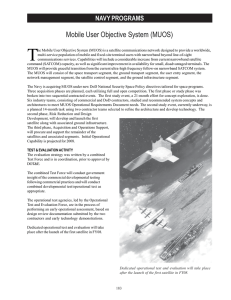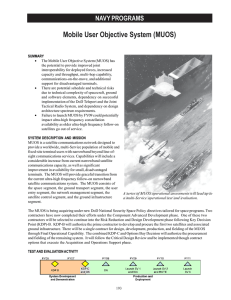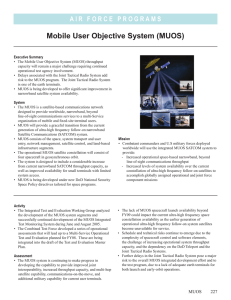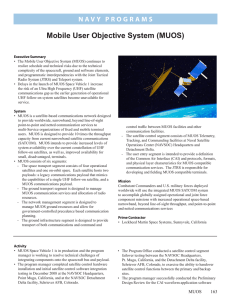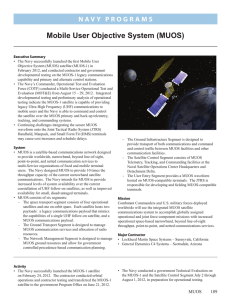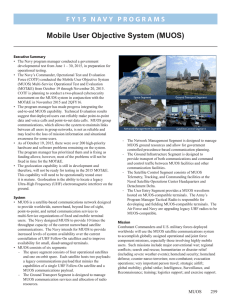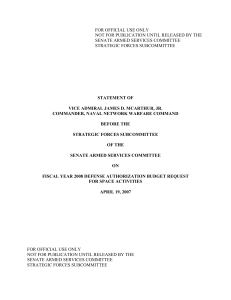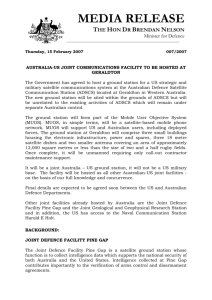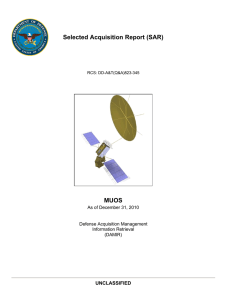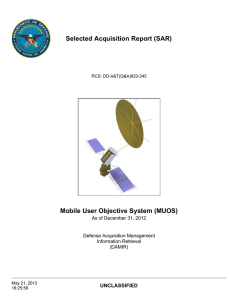Mobile User Objective System (MUOS)
advertisement
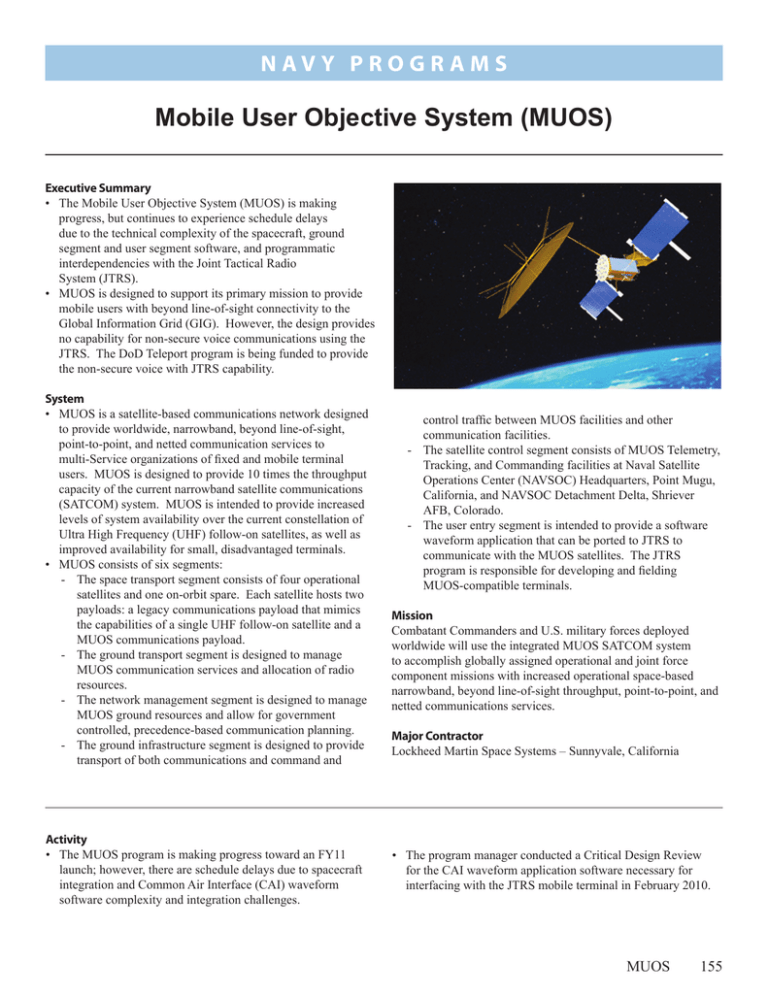
N a v y P ROGRAMS Mobile User Objective System (MUOS) Executive Summary • The Mobile User Objective System (MUOS) is making progress, but continues to experience schedule delays due to the technical complexity of the spacecraft, ground segment and user segment software, and programmatic interdependencies with the Joint Tactical Radio System (JTRS). • MUOS is designed to support its primary mission to provide mobile users with beyond line-of-sight connectivity to the Global Information Grid (GIG). However, the design provides no capability for non-secure voice communications using the JTRS. The DoD Teleport program is being funded to provide the non-secure voice with JTRS capability. System • MUOS is a satellite-based communications network designed to provide worldwide, narrowband, beyond line-of-sight, point-to-point, and netted communication services to multi-Service organizations of fixed and mobile terminal users. MUOS is designed to provide 10 times the throughput capacity of the current narrowband satellite communications (SATCOM) system. MUOS is intended to provide increased levels of system availability over the current constellation of Ultra High Frequency (UHF) follow-on satellites, as well as improved availability for small, disadvantaged terminals. • MUOS consists of six segments: - The space transport segment consists of four operational satellites and one on-orbit spare. Each satellite hosts two payloads: a legacy communications payload that mimics the capabilities of a single UHF follow-on satellite and a MUOS communications payload. - The ground transport segment is designed to manage MUOS communication services and allocation of radio resources. - The network management segment is designed to manage MUOS ground resources and allow for government controlled, precedence-based communication planning. - The ground infrastructure segment is designed to provide transport of both communications and command and Activity • The MUOS program is making progress toward an FY11 launch; however, there are schedule delays due to spacecraft integration and Common Air Interface (CAI) waveform software complexity and integration challenges. control traffic between MUOS facilities and other communication facilities. - The satellite control segment consists of MUOS Telemetry, Tracking, and Commanding facilities at Naval Satellite Operations Center (NAVSOC) Headquarters, Point Mugu, California, and NAVSOC Detachment Delta, Shriever AFB, Colorado. - The user entry segment is intended to provide a software waveform application that can be ported to JTRS to communicate with the MUOS satellites. The JTRS program is responsible for developing and fielding MUOS‑compatible terminals. Mission Combatant Commanders and U.S. military forces deployed worldwide will use the integrated MUOS SATCOM system to accomplish globally assigned operational and joint force component missions with increased operational space-based narrowband, beyond line-of-sight throughput, point-to-point, and netted communications services. Major Contractor Lockheed Martin Space Systems – Sunnyvale, California • The program manager conducted a Critical Design Review for the CAI waveform application software necessary for interfacing with the JTRS mobile terminal in February 2010. MUOS 155 N a v y P ROGRAMS • The program manager is installing the space control and ground infrastructure hardware in Hawaii, Virginia, Italy, and Australia. • The Commander, Operational Test and Evaluation Force (COTF) participated in integrated testing in accordance with the DOT&E-approved operational assessment plan. The integrated test team executed an integrated developmental/ operational test in November 2009. A second integrated test is scheduled for January 2011 that will lead to an Operational Assessment in early FY11. Assessment • Based upon COTF testing in FY10, MUOS is likely capable of completing its primary mission to provide mobile user beyond line-of-sight GIG connectivity, with the exception of non‑secure voice communications with JTRS. The DoD Teleport program is being funded to provide the non-secure voice with JTRS capability. • The delay of the launch of MUOS spacecraft beyond FY10 increases the risk of an UHF satellite communications gap as the earlier generation of operational UHF follow-on system satellites become unavailable for service. 156 MUOS • COTF cannot adequately test the MUOS capacity requirements in the MOT&E due to an insufficient number of JTRS-equipped mobile users. COTF will need to supplement MOT&E data with accredited modeling and simulation or other data to evaluate the system’s ability to operate at its planned capacity and link availability levels. Recommendations • Status of Previous Recommendations. The Navy has made progress on one of two recommendations for FY09. The Navy does not have plans in place to operationally load the system to evaluate capacity during the MOT&E. Without a means to load the MUOS system, the evaluation of MUOS capacity will rely solely on modeling and simulation results. • FY10 Recommendations. None.
